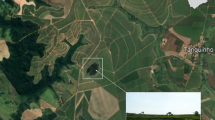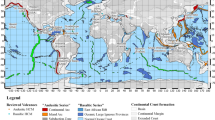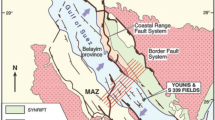Abstract
A multi-electrode resistivity survey, carried out over metasedimentary strata and metavolcanics in the Harare greenstone belt in northeastern Zimbabwe as part of a groundwater resources investigation, illustrates the ability of this technique to produce high-resolution images of the subsurface, which are useful for groundwater resources assessment. The resistivity results provide a clear view of the thickness of the weathered regolith and of the distribution of the various lithological units. Using a combination of apparent formation resistivity and inferred depth of weathering, it is possible to characterize the various lithologies on the geophysical profiles. These assigned lithologies show excellent correlation with the mapped geology, and the main lithologies, metabasalt, meta-arenite, granodiorite and banded iron formation can be clearly identified. The banded iron formation is characterized by low resistivity values, while a combination of the depth of weathering and resistivity values are used to distinguish between the meta-arenite on one hand and the metabasalt and granodiorite on the other. The multi-electrode method is successful in identifying potentially favourable zones for obtaining groundwater, such as areas with a maximum depth of weathered regolith, zones of fracturing and faulting, and high porosity and permeability zones associated with lithological contacts.
Résumé
La prospection électrique par la méthode de multiélectrodes, effectuée pour l’investigation des eaux souterraines cantonnés dans des roches métamorphiques d’origine sédimentaire et volcanique de la ceinture de Harare-Zimbabwe a mis en évidence les possibilités de cette technique de réaliser des images à grande résolution du sous-sol qui sont très utiles pour l’évaluation de la ressource en eaux souterraines. D’après la distribution de la résistance il résulte une image très claire de l’épaisseur des regolithes altérés ainsi que de la distribution des différentes unités lithologiques. D’après les profiles géophysiques on peut caractériser les différents lithologies en utilisant les résistivités apparentes de la formation respective et les informations sur la profondeur de la zone altérée. Les lithologies ainsi déterminées montrent une excellente corrélation avec les cartes géologiques et on peut très bien identifier les lithologies principales comme les metabasaltes et les meta-arenites, les granodiorites et les formations de fer rubanées. Cettes dernières sont caractérisées par des faibles valeurs de la résistivité, tandis que en utilisant les résistivité et la profondeur de la zone altérée on peut distinguer les meta-arenites de granodiorites et des metabasaltes. La méthode des multiélectrodes est donc capable d’identifier des formations favorables à l’accumulation en eau comme les zones de faille et des fractures, ainsi que les zones à grande porosité et perméabilité, associées aux contactes lithologiques.
Resumen
Un estudio de resistividad multi-electrodo que se llevó a cabo en estratos meta sedimentarios y metavolcánicos en el cinturón de rocas verdes de Harare, en la parte noreste de Zimbabwe, como parte de una investigación de recursos de agua subterránea, ilustra la capacidad de esta técnica para producir imágenes de alta resolución de la subsuperficie, las cuales son útiles para la evaluación de los recursos da agua subterránea. Los resultados de resistividad suministran una visión clara el espesor del regolito meteorizado y de la distribución de varias unidades litológicas. Mediante el uso de una combinación de resistividad aparente de formación y de una profundidad inferida de meteorización, es posible caracterizar las diferentes litologías en los perfiles geofísicos. Estas litologías asignadas muestran una excelente correlación con la cartografía geológica y se pueden identificar las litologías predominantes como metabasalto, meta-arenita, granodiorita y formación de hierro bandeado. Esta última se caracteriza por valores bajos de resistividad, mientras que se utiliza una combinación de profundidad de meteorización y valores de resistividad, para distinguir entre meta-arenita por un lado y metabasalto y granodiorita por el otro. El método multi-electrodo es exitoso para identificar zonas potencialmente favorables para captar agua subterránea, las cuales pueden ser áreas con una profundidad máxima de regolito meteorizado, o bien zonas de fracturamiento y fallamiento, o también zonas de porosidad y permeabilidad altas asociadas con contactos litológicos.





Similar content being viewed by others
References
Acworth RI (1987) The development of crystalline basement aquifers in a tropical environment. Quart J Eng Geol 20:265–272
Baldock JW (1991) The geology of the Harare greenstone belt and surrounding granitic Terrain. Zimbabwe Geol Surv Bull 94:213pp
Barker R (1981) The offset system of electrical resistivity sounding and its use with a multicore cable. Geophys Prospect 29:128–143
Dahlin T (1993) On the automation of 2D resistivity surveying for engineering and environmental applications. PhD Thesis. Department of Engineering Geology, Lund Institute of Technology, Lund University, Sweden. ISRN: LUTVDG/TVTG1007SE. ISBN 9162810324, 187 pp
de Groot-Hedlin C, Constable S (1990) Occam’s inversion to generate smooth, two-dimensional models from magnetotelluric data. Geophysics 55:1613–1624
Interconsult (1987) National master plan for rural water resources development, Vol 2.2, Hydrogeology. Government of Zimbabwe
Loke MH, Barker RD (1996a) Rapid least squares inversion of apparent resistivity pseudosections by a quasi Newton method. Geophys Prospect 44:131–152
Loke MH, Barker RD (1996b) Practical techniques for 3D resistivity surveys and data inversion. Geophys Prospect 44:499–523
Parasnis DS (1986) Principles of applied geophysics. 4th edn. Chapman and Hall, London, UK, 402 pp
Sasaki Y (1992) Resolution of resistivity tomography inferred from numerical simulation. Geophys Prospect 40:453–464
Acknowledgements
The research was partly funded by the Swedish Agency for Research Cooperation with Developing Countries (SAREC) through the link with the Institute of Geotechnology, Lund University, Sweden, within the bilateral project “Development of Groundwater Resources in Zimbabwe” and the British Council through the link with the School of Earth Sciences, University of Leeds, UK, within the “Developmental Geophysics Link Scheme”. We thank David L. Campbell and an anonymous reviewer for their helpful comments on an earlier version of this paper
Author information
Authors and Affiliations
Corresponding author
Rights and permissions
About this article
Cite this article
Owen, R.J., Gwavava, O. & Gwaze, P. Multi-electrode resistivity survey for groundwater exploration in the Harare greenstone belt, Zimbabwe. Hydrogeol J 14, 244–252 (2006). https://doi.org/10.1007/s10040-004-0420-7
Received:
Accepted:
Published:
Issue Date:
DOI: https://doi.org/10.1007/s10040-004-0420-7




